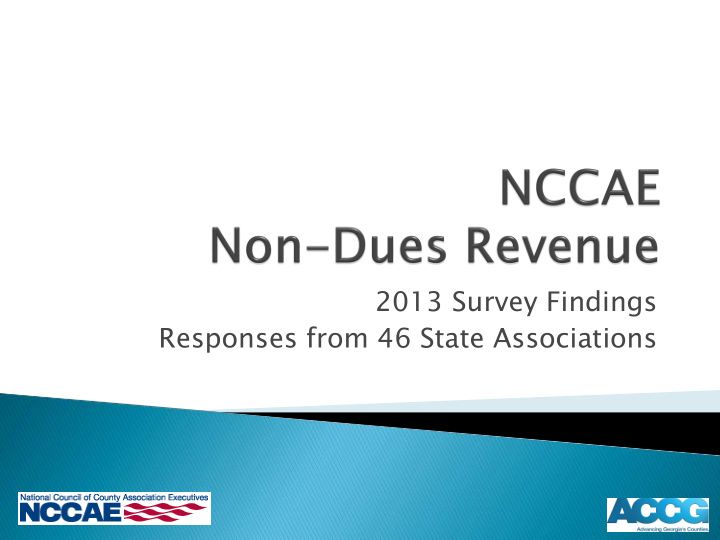



2013 Survey Findings Responses from 46 State Associations
11% 11% 34% 23% 17% 55% 17% 32% < 21% 21 to 40% < 21% 21 to 40% 41 to 60% > 60% 41 to 60% > 60% Dues Revenue as a % of an Insurance Program Revenue as Association’s Budget a % of an Association’s Budget 2
80% 74% Yes No 70% 60% 55% 52% 48% 50% 45% 40% 26% 30% 20% 10% 0% Staff Dedicated to Non- Field Staff Promoting Existing Staff Capacity for Dues Programs Non-Dues Programs New Non-Dues Programs 3
Deferred Compensation Program (77%) National Purchasing Cooperative (71%) Workers’ Compensation Group Pool (63%) Property & Casualty Insurance (52%) Other Insurance Programs (50%) Royalty/Incentive Partnership Programs (46%) Meeting and Event Planning Services (46%) Credit Card Programs (10%) 4
71% of Respondents indicated they had other unique non-dues revenue generating programs ◦ Consulting Services/IT-tech, Software Services ◦ Business Partnerships ◦ Communications/PR for Counties ◦ Cash Management/Investment/Collection Services ◦ Bid/Purchasing/Energy, Fuel Procurement ◦ Real Estate Rental Income 5
100% Yes No 89% 86% 90% 84% 80% 70% 60% 50% 40% 30% 16% 20% 14% 11% 10% 0% Laws Precluding State Mandatory Bidding Members Eligible to Association Non-Dues Requirments Purchase From State Programs Contracts 7
Respond to a County Request (77%) Implement a Program offered by NACo (68%) Unsolicited Proposal from Supplier/Vendor (43%) Respond to a Membership Survey (45%) Replicate a Program of another Association (36%) 74% of survey respondents indicated they do NOT respond to RFPs 9
Board of Directors (70%) Enterprise Committee (6%) Staff (6%) Other (17%) – combination of the above 10
Reference Checks (76%) Advisory Committee Review (66%) Audit/Financial Review (33%) Trial-run as a Pilot (28%) On-site Inspections/Audit (22%) 11
Revenues support the hiring & retention of association staff Collective buying power results in: ◦ Lowers costs for products & services ◦ Supports the development of “custom built” services and programs for members ◦ Streamlines bidding resulting in reduced administrative time and costs for members purchasing goods and services 13
Outreach Evaluation Membership Feedback Partnerships 14
Educate members about programs Visits members Report annual savings Market to county staff, not just elected members 15
Monitor use of the program Ensure members are receiving value (savings) from the program Identify changing needs of members Adapt & market program as needed 16
Successful programs are created in response member needs Not always about revenue, programs provide a “touch point” or provide a vital service a member can’t live without 17
Not about selling services – partners should be seen as an extension of the association by being: Responsive; Creditable; Long-term (not the quick sale); and More efficient & economical than securing services individually 18
Management & Consulting Services Management of Federal Juvenile Justice Funds Association prepares state grant applications, allocates sub-grants, manages funds Law Enforcement Special Operations Reimbursement Risk pool used to leverage federal justice assistance grants Traffic Safety Resource Officer Training Agreement with state DOT to fund association training staff 19
Financial & Legal Services Debt Set-off Catastrophic legal expense relief, prepaid legal services, and capital crimes defense fund programs 20
Cost Savings Programs (78%) Partnerships with other state associations (52%) Providing value-added services (52%) Retirement, health, IT, procurement, financial services (43%) County leadership (33%) 21
Are members interested in association- sponsored or endorsed programs that offer non-dues revenue opportunities? 19% Yes No 81% 23
Recommend
More recommend